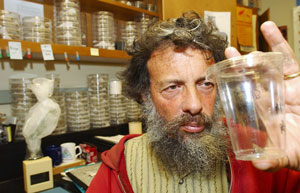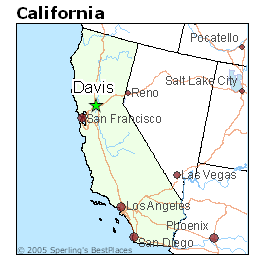Invasive Species Can Be Good!
Incorporating Invasive Species Research into Elementary School Lessons
Created by: Bianca Re, Angela Jedele, Meghan Boer, Kimberlin Johnston
Are there any examples of an invasive species that have positively impacted an ecosystem?
This is the question we, aspiring future teachers, have been investigating for the past month. Whenever someone brings up the topic of invasive species, it almost always has a negative connotation associated with it. The name itself leads you to believe that it is undesirable and harmful. We were curious if there are any examples of invasive species actually being good or beneficial to an ecosystem. While most of the research we found was negative, we did find an example of a positive invasive species.
 Art Shapiro is an ecologist who lives in Davis, California. One day, a neighbor sent her son to his home to find out just what bug was eating all of the plants in her garden. Shapiro was shocked when he discovered that the bug was the larvae of the Red Admiral Butterfly. The natural host plant of the Red Admiral is the Stinging Nettle, which is a plant not known to be in Davis. Shapiro was ecstatic to find that the Red Admiral switched its host and adapted to an alien plant that has a similar chemistry to the Stinging Nettle called Baby’s Tears, a ground covering plant commonly used for decoration in gardens. He compared finding the host plant to finding a “Needle in a haystack”. He knew the butterflies in Davis were host switching but he had never witnessed it. This sparked a study focused on the butterfly population of Davis and their host plants.(4)
Art Shapiro is an ecologist who lives in Davis, California. One day, a neighbor sent her son to his home to find out just what bug was eating all of the plants in her garden. Shapiro was shocked when he discovered that the bug was the larvae of the Red Admiral Butterfly. The natural host plant of the Red Admiral is the Stinging Nettle, which is a plant not known to be in Davis. Shapiro was ecstatic to find that the Red Admiral switched its host and adapted to an alien plant that has a similar chemistry to the Stinging Nettle called Baby’s Tears, a ground covering plant commonly used for decoration in gardens. He compared finding the host plant to finding a “Needle in a haystack”. He knew the butterflies in Davis were host switching but he had never witnessed it. This sparked a study focused on the butterfly population of Davis and their host plants.(4)
Red Admiral Butterfly Resting on Baby’s Tears Solleria Solleri
 In Davis, California the butterfly fauna has been intensely monitored since the winter of 1971 and 1972 by Art Shapiro. It may be the best documented fauna in the United States. Twenty-nine of the thirty-two butterflies that breed in Davis depend on the alien plants invasive to the area. These butterflies breed frequently on the cultivated herbaceous alien plants in gardens, which make them dependent on the plant. There are various plants that the butterflies of Davis, California need, but the most used plant is the Hollyhock plant, also known as the Alcea Rosea. This introduced plant is a biennial or short lived perennial that is about 4-8' tall. The stout central stem is unbranched or sparingly branched, it is light green, terete, and somewhat hairy. The blades of the alternate leaves are up to 8" long and across. Each leaf blade of the hollyhock plant is oval in outline and indented at the base where the petiole joins the blade. The upper surface of each leaf blade is medium green, slightly pubescent, and wrinkled from fine veins. The lower surface is light green and also pubescent. The plant has axillary flowers that are produced from the axils of the upper leaves. These flowers occur individually or in small clusters along the central stem, have five petals and are usually a shade of white, pink, or purplish red.(3)
In Davis, California the butterfly fauna has been intensely monitored since the winter of 1971 and 1972 by Art Shapiro. It may be the best documented fauna in the United States. Twenty-nine of the thirty-two butterflies that breed in Davis depend on the alien plants invasive to the area. These butterflies breed frequently on the cultivated herbaceous alien plants in gardens, which make them dependent on the plant. There are various plants that the butterflies of Davis, California need, but the most used plant is the Hollyhock plant, also known as the Alcea Rosea. This introduced plant is a biennial or short lived perennial that is about 4-8' tall. The stout central stem is unbranched or sparingly branched, it is light green, terete, and somewhat hairy. The blades of the alternate leaves are up to 8" long and across. Each leaf blade of the hollyhock plant is oval in outline and indented at the base where the petiole joins the blade. The upper surface of each leaf blade is medium green, slightly pubescent, and wrinkled from fine veins. The lower surface is light green and also pubescent. The plant has axillary flowers that are produced from the axils of the upper leaves. These flowers occur individually or in small clusters along the central stem, have five petals and are usually a shade of white, pink, or purplish red.(3)
The Hollyhock (Alcea Rosea) Plant.
 The richest butterfly faunas in Davis are located today in neighbourhoods near the community gardens where these alien plants are located. After reading these articles about the invasive alien plants actually helping the butterflies in Davis, California to thrive, we have come to the conclusion that there are, in fact, examples of an invasive species positively impacting an ecosystem, that ecosystem being the area of Davis, California. (3)
The richest butterfly faunas in Davis are located today in neighbourhoods near the community gardens where these alien plants are located. After reading these articles about the invasive alien plants actually helping the butterflies in Davis, California to thrive, we have come to the conclusion that there are, in fact, examples of an invasive species positively impacting an ecosystem, that ecosystem being the area of Davis, California. (3)
So, you’ve all read about the butterflies and alien plants of Davis, California… How do you use this information in your classroom?
Lower Elementary Applications: One way to use this information in your classroom is to use The Life Cycle of a Butterfly Kit with your students. Talking about the life cycle of a butterfly with your students will lead you to discussing where butterflies live and what they feed on. Using that information, you can examine how the plants in Urban California were affected by certain butterflies living in the area. From there, you could possibly make connections to the butterfly population in your own town. The Life Cycle of a Butterfly Kit includes - a cup of 5 caterpillars complete with nutritious food, a feeding pipette, pop-up reusable 11.5-inch tall mesh habitat perfect for butterfly viewing, and caterpillars to butterflies instruction guide. You could also take lower elementary students on a field trip to a butterfly garden, but instead of having such an in depth worksheet to go along with it like you would have for upper elementary students (see upper elementary applications for more information), you could have the students fill out this worksheet and have them draw pictures of what they see and what is happening in the garden, then discuss it when you get back to the classroom.
 Upper Elementary Applications: Another way to incorporate this information is to take a field trip to a Butterfly Garden in Michigan. Before going on this field trip, have each student or a pair of students come up with a question about where butterflies live or how/what they eat. While on the field trip, the students will be asked to try to find the answer to their question and bring the results back to the classroom for further investigation. They can use this worksheet, which will include a space for students to write down the 4 stages of a butterfly, 2 facts they learned, 2 questions they have, and an opinion they have about butterflies. The students could also make observations and draw pictures of the plants and butterflies that they see at the butterfly garden.
Upper Elementary Applications: Another way to incorporate this information is to take a field trip to a Butterfly Garden in Michigan. Before going on this field trip, have each student or a pair of students come up with a question about where butterflies live or how/what they eat. While on the field trip, the students will be asked to try to find the answer to their question and bring the results back to the classroom for further investigation. They can use this worksheet, which will include a space for students to write down the 4 stages of a butterfly, 2 facts they learned, 2 questions they have, and an opinion they have about butterflies. The students could also make observations and draw pictures of the plants and butterflies that they see at the butterfly garden.
Butterfly Gardens in Michigan:
Resources:
No comments:
Post a Comment